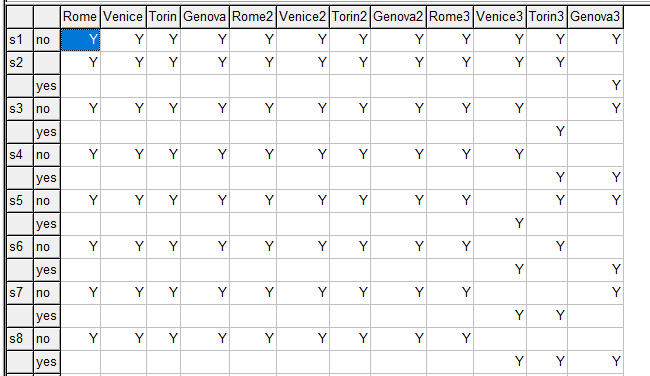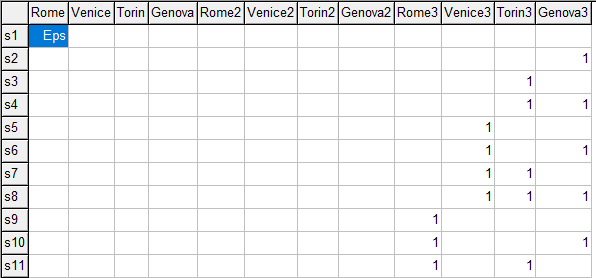Problem
This is a multi-objective (a.k.a. multi-criteria) problem. We are asked to find all Pareto optimal solutions (i.e. non-dominated solutions) consisting of a set of items [1]. We have the following data:
---- 42 PARAMETER data %%% data set with 12 items cost hours people Rome 1000 5 5 Venice 200 1 10 Torin 500 3 2 Genova 700 7 8 Rome2 1020 5 6 Venice2 220 1 10 Torin2 520 3 2 Genova2 720 7 4 Rome3 1050 5 5 Venice3 250 1 8 Torin3 550 3 8 Genova3 750 7 8
We want to optimize the following objectives:
- Maximize number of items selected
- Minimize total cost
- Minimize total hours
- Minimize total number of people needed
In addition we have a number of simple bound constraints:
- The total cost can not exceed $10000
- The total number of hours we can spend is limited to 100
- There are only 50 people available
 |
| Vilfredo Pareto [2] |
Approach 1: complete enumeration
This is a small data set with 12 items. This means we have only \(2^{12}=4,096\) possible combinations. Some of these represent infeasible solutions. Let's have a look.
In the next paragraphs I will show a GAMS program without a model: no variables and no constraints and no solve statement. I will use some less familiar GAMS constructs to (1) enumerate all possible solutions and (2) to filter out dominated solutions. I will take small steps, because of the high level of exotisism of these GAMS steps.
1.1 Generating all combinations
GAMS has a tool to generate a power set (the set of all sub sets). We can use this to generate all possible combinations.
sets
i 'items' /Rome,Venice,Torin,Genova,Rome2,Venice2, Torin2,Genova2,Rome3,Venice3,Torin3,Genova3 / k 'objectives' /cost,hours,people,items/ s 'solution points' /s1*s4096/ ; * * check if set s is large enough * scalar size 'size needed for set s'; size = 2**card(i); abort$(card(s) * * generate all combinations * sets base 'used in next set' /no,yes/ ps0(s,i,base) / system.powersetRight / ps(s,i) 'power set' ; ps(s,i) = ps0(s,i,'yes'); display ps; |
The unusual construct system.powersetRight will populate set ps0 with information about the power set. I hardly ever use the Power Set, but there is a well-known formulation for the TSP (Traveling Salesman Problem), that can use this [3]. The generated set ps0 looks like (I pivoted things around to make the table a bit more readable):
 |
| ps0 with second index pivoted |
This has a little bit more info than we need: we only need the "yes" rows. This "yes"-only part is stored in set ps. It looks like:
 |
| Set ps |
It looks like we are missing solution s1 here. That is because GAMS stores everything sparse. A row without any Y elements is just not stored. The bottom of set ps looks like:
 |
| Bottom of set ps |
Indeed we have all 4096 solutions (well, except for that funny first row).
1.2 Form our X parameters
With this we can form our \(x_{s,i}\in \{0,1\}\) parameter. We want a 0-1 parameter for two reasons: we want numerical values to evaluate our objectives, and we need this parameter later on to use a filter tool.
*
* make a parameter out of this * parameter x(s,i) 'solutions'; x(s,i) = ps(s,i); * make sure row 1 exists: introduce an EPS x(s,i)$(ord(s)=1 and ord(i)=1) = eps; display x; |
A trick to make the row not disappear is to insert an EPS value. An EPS value is like a zero when operated upon. But it exists: GAMS will no longer assume the whole row does not exist.
 |
| Parameter x with EPS value |
1.3 Form the F values
Now we have all possible solutions in the \(x\) space, we can start calculating the \(f\) values: the objectives.
table data(i,k) '### data set with 12 items'
cost hours people Rome 1000 5 5 Venice 200 1 10 Torin 500 3 2 Genova 700 7 8 Rome2 1020 5 6 Venice2 220 1 10 Torin2 520 3 2 Genova2 720 7 4 Rome3 1050 5 5 Venice3 250 1 8 Torin3 550 3 8 Genova3 750 7 8 ; data(i,'items') = 1; parameter f(s,k) 'objective values'; f(s,k) = sum(i, data(i,k)*x(s,i)); display f; |
First we need to introduce our data. One objective is missing from the columns: the items. This is simply a column with ones: each item counts as one. With this we can calculate all \(f\) values in one swoop. The display output looks like:
---- 56 PARAMETER f objective values cost hours people items s1 EPS EPS EPS EPS s2 750.000 7.000 8.000 1.000 s3 550.000 3.000 8.000 1.000 s4 1300.000 10.000 16.000 2.000 s5 250.000 1.000 8.000 1.000 s6 1000.000 8.000 16.000 2.000 s7 800.000 4.000 16.000 2.000 s8 1550.000 11.000 24.000 3.000 s9 1050.000 5.000 5.000 1.000 s10 1800.000 12.000 13.000 2.000 . . . s4089 5930.000 37.000 52.000 9.000 s4090 6680.000 44.000 60.000 10.000 s4091 6480.000 40.000 60.000 10.000 s4092 7230.000 47.000 68.000 11.000 s4093 6180.000 38.000 60.000 10.000 s4094 6930.000 45.000 68.000 11.000 s4095 6730.000 41.000 68.000 11.000 s4096 7480.000 48.000 76.000 12.000
I only show the head and the tail of the display here. As we can see, some objective values violate the constraints. E.g. the last solution s4096, needs 76 people while we only have 50 available.
1.4 Constraint handling
We need to remove all solutions that violate the constraints. This can be done as follows:
parameter
UpperLimit(k) 'bounds'/
cost 10000 hours 100 people 50 /; upperlimit(k)$(upperlimit(k)=0) = INF; set infeas(s) 'infeasible solutions'; infeas(s) = sum(k$(f(s,k)>UpperLimit(k)),1); scalar numfeas 'number of feasible solutions'; numfeas = card(s)-card(infeas); display numfeas; * kill solutions that are not feasible x(infeas,i) = 0; f(infeas,k) = 0; |
This code removes all infeasible solutions from \(x\) and \(f\). Note that assigning a zero makes the corresponding records disappear: this is because GAMS stores everything sparse. The display shows:
---- 71 PARAMETER numfeas = 3473.000 number of feasible solutions
1.5 Filter out dominated solutions
In the result set there are quite a few dominated solutions. A solution \(f_1\) dominates \(f_2\) if:
- All objectives are better or equal
- There is one objective which is strictly better
Looking again at some of our solutions
---- 87 PARAMETER f objective values cost hours people items s1 EPS EPS EPS EPS s2 750.000 7.000 8.000 1.000 s3 550.000 3.000 8.000 1.000 s4 1300.000 10.000 16.000 2.000 s5 250.000 1.000 8.000 1.000 s6 1000.000 8.000 16.000 2.000 s7 800.000 4.000 16.000 2.000
we see that for this small subset
- s1 is non dominated
- s5 dominates s2 and s3
- s7 dominates s4 and s6
Remember we are minimizing cost, hours and people while maximizing items.
GAMS has a tool to filter large data sets, call mcfilter.
D:\projects>mcfilter
No
input file specified
Usage:
mcfilter xxx.gdx
mcfilter
will remove duplicate and dominated points in a
multi-criteria
solution set.
The
input is a gdx file with the following data:
parameter X(point, i): Points containing binary values.
If all zero for a
point, use EPS.
parameter F(point, obj): Objectives for
the points X.
If all zero for a
point, use EPS.
parameter S(obj): Direction of each objective:
1=max,-1=min
The
output will be a gdx file called xxx_res.gdx with the same parameters
but
without duplicates and dominated points.
D:\projects>
|
The X and the F parameters conform to our parameters. So the only thing to add are the signs of the objectives.
parameter sign(k) 'sign: -1:min, +1:max' /
(cost,hours,people) -1 items +1 /; execute_unload "feassols",x,f,sign=s; execute "mcfilter feassols.gdx"; |
We see:
mcfilter v3. Number of records = 3473 Number of X variables = 12 Number of F variables = 4 Loading GDX data = 15 ms After X Filter, count = 3473 X Duplicate filter = 0 ms After F Filter, count = 83 F Dominance filter = 0 ms Writing GDX data = 0 ms
There are 83 non-dominated or Pareto optimal solutions.
The final Pareto set looks like:
 |
| Non-dominated solutions |
I list here the \(x\) values and the \(f\) values. As can be expected, a solution with all \(x_i=0\) is part of the Pareto set: doing nothing is very cheap; no other solution can beat this on price. Interestingly, project Genova3 is never selected.
Approach 2: use a series of MIP models
There is another way to generate these 83 points: use a MIP model. Or rather a series of MIP models. We use an algorithm like:
- Generate an optimal MIP solution. If infeasible: STOP.
- Add constraints: new solutions must be better in one objective
- Go to step 1.
This approach will be shown in part 2.
Conclusion
We have described a small multi-objective problem. We established that:
- There are 4096 total combinations possible.
- After removing the infeasible solutions, there are 3473 solutions left.
- After removing the dominated solution, we are left with 83 Pareto optimal solutions.
We used some less well-known GAMS tools in our script: a power set generator and a multi-criteria filter.
References
- Best Combination Algorithm of Complex Data with Multiple Constraints, https://stackoverflow.com/questions/55514627/best-combination-algorithm-of-complex-data-with-multiple-contraints
- Vilfredo Pareto, https://en.wikipedia.org/wiki/Vilfredo_Pareto
- TSP Powerset Formulation, https://yetanothermathprogrammingconsultant.blogspot.com/2009/02/tsp-powerset-formulation.html
Dear Mr. Kalvelagen, I just want to thank you for your sharing. As a senior ChE student, I have been working on MOMILP for my graduation project, so your solution caught my attention. I’m looking forward to seeing the Approach 2. Best regards from Istanbul
ReplyDeleteJust because I did my PhD on it: there is a third (not very well known approach): you can solve the optimization problem parametrically (i.e. as a function of the weights/epsilons in your MO formulation. Here a couple of papers:
ReplyDelete[0]: General multi-parametric programming intro - https://www.sciencedirect.com/science/article/pii/S0263876216303276
[1]: Multi-objective optimization using multi-parametric programming - https://www.sciencedirect.com/science/article/pii/S0098135415003269
[2]: Multi-parametric programming using binary parameters - https://link.springer.com/article/10.1007/s10898-016-0463-z
But to be honest, it won't scale very well most likely, there are only implementations in MATLAB for multi-parametric programming solvers. So it's basically a curiosity :-)